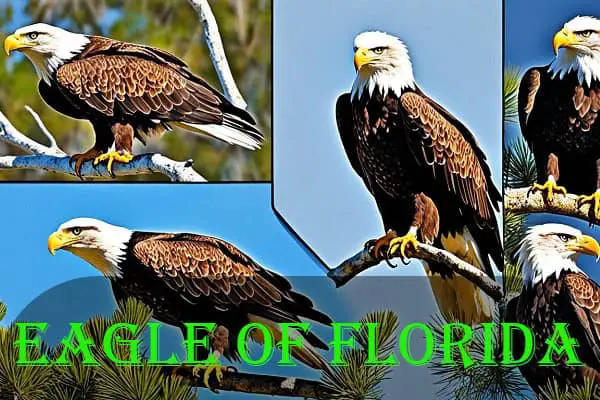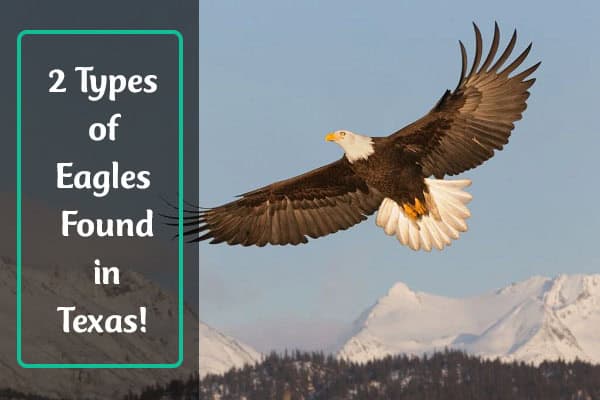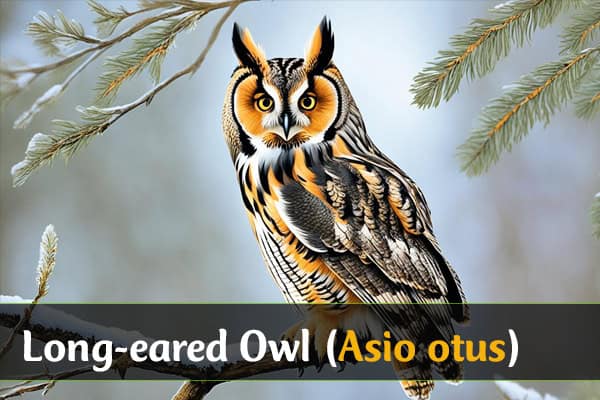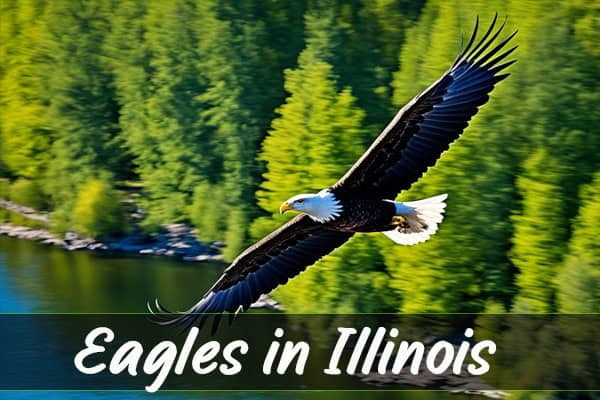4 Types of Eagles in Florida (ID Guide With Pictures)
Ever wondered about the Eagles living in Florida? Did you know the Bald Eagle, one of North America’s largest birds, can have a wingspan bigger than the Great Blue Heron? These eagles symbolize strength and freedom and are key to our ecosystem. Let’s explore the world of eagles in Florida, focusing on four types: the Bald Eagle, golden eagle, White-tailed Eagle, and immature golden Eagle, all of which are fascinating raptors.
Join us as we dive into these amazing birds’ unique traits, homes, and habits. We’ll share clear pictures to help you identify them. We’ll also talk about where and how to see eagles in Florida. Whether you love birds or just enjoy nature, this guide will amaze and teach you.
Introduction to Eagles in Florida
Florida is home to a wide variety of wildlife, including eagles, which are a significant part of the raptor family. These birds are not just beautiful; they are also important to our culture and environment. Bird watchers love seeing eagles in natural places, like by the coast or big lakes, where they hunt as skilled raptors.
Learning about eagles in Florida shows us how they adapt to different places. We learn about the Bald Eagles and how they live. We see why they are important and how we can help protect them. This helps us understand the balance of nature and the need to keep their homes safe.
Watching eagles in Florida is an exciting adventure. Their big wings and flying skills amaze everyone. It makes us appreciate nature more and want to protect these amazing birds and their homes.
1. Bald Eagles
- Scientific Name: Haliaeetus leucocephalus
- Size: 28-40 inches
- Weight: 6.5-14 pounds
- Lifespan: 20-30 years (up to 50 years in captivity)
- Diet: Primarily fish, also birds, mammals, and carrion
- Call: High-pitched, whistling chirps
- Speed: 30-35 mph (up to 100 mph in a dive)
The bald eagle is a symbol of America’s strength and beauty. Its striking appearance and interesting behavior are characteristic of the raptor family. Learning about it helps us appreciate this bird and its place in nature.
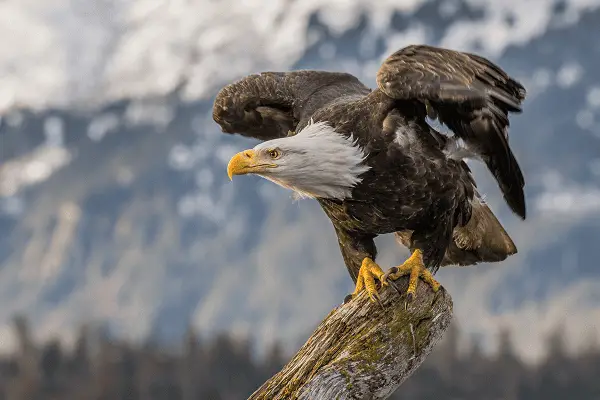
Description of Bald Eagles
The bald eagle looks impressive with its white head and tail against a dark brown body. It has a wide wingspan, making it a great flyer. Its large head and bright yellow bill add to its regal look.
Young eagles have a mix of brown and white feathers. They change to full adult colors over five years.
Habitat and Behavior of Bald Eagles
Bald eagles live in many places, like lakes, rivers, and coastal areas. They love places with lots of fish. They hunt by flying over water to spot fish.
They mostly eat fish and carrion and compete with other birds for food. Watching them fly shows their skill and care for their young.
2. Golden Eagles
- Scientific Name: Aquila chrysaetos
- Size: 26-40 inches
- Weight: 6-15 pounds
- Lifespan: 15-20 years (up to 30 years in captivity)
- Diet: Small to medium-sized mammals, birds, reptiles
- Call: Weak, high-pitched whistling
- Speed: 30-50 mph (up to 150 mph in a dive)
The golden eagle is a bird of prey that catches our eye. Its majestic look stands out, making it unique among eagles.
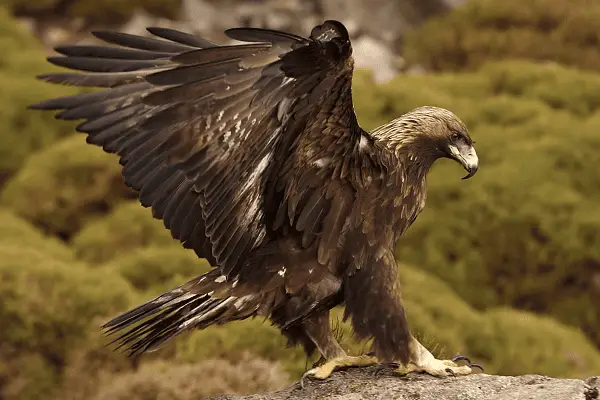
Appearance and Characteristics of Golden Eagles
The golden eagle looks striking, with dark brown feathers and a golden sheen on its neck. It’s one of the biggest eagles in North America, and adults weigh between 7.9 and 11 pounds.
Eagles have a wide wingspan, which allows them to glide smoothly, making them a beautiful sight in the sky. Young eagles have white patches on their wings and tails, which fade as they grow older.
Habitat Preferences of Golden Eagles
Golden eagles live in open areas, like mountains and hills. They nest on cliffs for safety. In Florida, they are less common than in other states.
Behavioral Traits of Golden Eagles
Golden eagles usually fly alone or with a mate. They are skilled hunters who use gliding and soaring to find food. They fly low to the ground or use high spots to hunt.
Florida’s Bald Eagles: A Closer Look
Nesting bald eagles are a stunning sight in Florida, showcasing their impressive plumage. These birds build big nests in tall trees or man-made structures, and their nests can grow up to 13 feet wide.
Their nesting season peaks in late winter. During this time, they lay one to three eggs, which hatch in about 35 days. It’s amazing to see how these nests grow and change each season.
Nesting Habits of Bald Eagles in Florida
Bald eagles in Florida are very adaptable. In Central and North Florida, they like tall pine trees. In South Florida, they prefer mangrove areas.
Their nests are often 20 feet off the ground. This shows they choose safe and easy-to-reach spots for food.
Major Populations in Florida
Florida has many bald eagles, especially by the coast and near big waters, making it one of the best places to observe eagles in the lower 48 states. Thanks to conservation, their numbers have grown, making Florida’s nature even more beautiful.
Eagles in Florida: Diversity and Adaptation
Florida’s different ecosystems help eagles thrive. The bald eagle is the most common, and its numbers have increased dramatically since DDT was banned in 1972.
The subtropical climate helps bald eagles. But other eagles, like golden and white-tailed eagles, have their own ways of adapting. They find food and places to nest in coastal and inland areas.
Bald eagles often build nests near water, like lakes and rivers. This helps them hunt and find mates. Female bald eagles care for their young more than males. They also have big wings, up to 8 feet for females.
Watching eagles shows how they adapt to survive. Their ways help keep our ecosystems balanced. Learning about eagles in Florida enables us to understand their important role in nature.
3. White-tailed Eagles
- Scientific Name: Haliaeetus albicilla
- Size: 26-37 inches
- Weight: 7-15 pounds
- Lifespan: 20-25 years
- Diet: Primarily fish, birds, and carrion
- Call: Harsh, barking “kra-kra-kra”
- Speed: 30-40 mph (up to 70 mph in a dive)
The white-tailed eagle is one of the rarest in Florida. It has a big size and interesting behaviors. Bird lovers find it fascinating. Knowing how to spot and track these eagles helps us appreciate them more.

Identification Features of White-tailed Eagles
The white-tailed eagle is easy to spot because of its size and looks. Key features include:
- Large wingspan measuring between 5 feet 10 inches to 8 feet, making it one of the largest eagles.
- It has a pale head and a formidable beak that contribute to its distinctive profile.
- Prominent white tail feathers that contrast sharply with its darker body, making it easier to spot in flight.
Migration Patterns and Breeding Grounds
These eagles migrate to Florida during certain times. They seek warmer weather. Their breeding grounds are in cooler areas, perfect for nesting.
They return to Florida for winter but stay loyal to their breeding places, which shows their adaptability and strength.
Identifying Eagles in Florida: Key Features
Knowing how to spot eagles in Florida makes it easier to see them. With some tips, we can see how amazing and special these birds are. Knowing their size, colors, and behavior helps us tell them apart.
Common Identification Tips for Eagles
The first thing to notice is their size and shape. Bald eagles are easy to spot because of their white heads and dark bodies. Golden eagles are less obvious, blending in with their surroundings. Key features include:
- The white feathers on a bald eagle’s head and tail.
- Golden eagles look bigger when they fly.
- Juvenile bald eagles have brown feathers that change as they grow.
Each eagle acts differently. Bald eagles fly over water looking for fish, while golden eagles hunt on land. Knowing this makes watching them more fun.
Seasonal Variations and Sightings
Eagle sightings change a lot throughout the year. In Florida, winter is the best time to see eagles, but they can be spotted year-round. This is when they gather near good places to find food.
Bald eagles migrate based on food and where they nest. Watching them helps us learn about their lives. With patience, we can see these amazing birds in their home.
The Importance of Eagles in Our Ecosystem
Eagles are amazing to see in the sky. They are key to our ecosystems. As top predators, they keep the balance for many species to live.
Their presence shows a healthy environment. This highlights why we must protect their homes.
Role of Eagles as Apex Predators
Eagles are top predators. They control the numbers of their prey, which helps keep the ecosystem healthy.
In Florida, eagles mainly eat fish, birds, and small mammals. Their sharp eyes and hunting skills let them find food far away, making them one of the most efficient eagles typically found in the region. This shows they are at the top of the food chain.
Eagles and Biodiversity in Florida
Eagles in Florida mean the ecosystem is doing well. In 2014, there were 1,499 nesting pairs of bald eagles. This is a big jump from 1973’s 88 pairs.
Florida’s diverse habitats are great for eagles. They help eagles thrive and attract people who love to see them. Protecting eagles and their homes helps Florida’s biodiversity. This benefits the whole ecosystem.
How to Spot Eagles in Florida
Finding the right spots in Florida is key if you love eagle-watching. The state has many places where eagles are common. We’ll look at top spots and what gear you need for a great time.
Best Locations for Eagle Watching in Florida
Here are some top places for eagle-watching in Florida. Each spot offers a chance to see these amazing birds:
| Location | Details |
|---|---|
| Prairie Lakes Unit, Three Lakes WMA | Home to the heaviest concentration of bald eagle nests in the Southeast, with around 150 nests. |
| Paynes Prairie Preserve State Park | Accessible eagle nests near Lake Wauburg, visible from a picnic area off Hwy. 441. |
| Ocala National Forest | Rich habitat with high density around Lake George. Some nests require hiking through swampy areas. |
| Withlacoochee State Forest is a great location for spotting various raptors, including bald eagles. | Accessible eagle nest site near the Richloam tract by car followed by a short hike. |
| Lake Woodruff National Wildlife Refuge | It is a good site for spotting bald eagles, especially near ponds accessible via walking paths. |
| Lake Kissimmee State Park | Home to many nesting bald eagles, with sightings of over a dozen eagles in a single day. |
| Merritt Island National Wildlife Refuge | Reliable eagle sightings with detailed information from the visitor center. |
| Pine Island is known for its concentrations of nesting bald eagles. | Great location along County Road C-767 with plentiful eagle nests. |
| Charlotte Harbor Environmental Center | Eagle sightings from December to April, accessible via hiking trails. |
| Everglades National Park | Bald eagles can be observed at Paurotis Pond and the Flamingo end of the park road. |
| Wakulla Springs State Park | Several eagle nests are visible from the park’s clear waters. |
Recommended Gear for Eagle Enthusiasts
For the best eagle watching, use these items:
- High-quality binoculars for clear viewing of distant nests and flying eagles.
- Cameras with zoom lenses to capture stunning photos of these majestic birds.
- Field guides to assist in identifying different eagle species and understanding their behaviors.
With the right gear and knowledge, eagle-watching in Florida will be unforgettable.
Conservation Efforts for Eagles in Florida
We all know how important it is to protect eagles in Florida. Our state is working hard to keep these birds safe, thanks to laws and community help.
Legal Protection and Conservation Practices
In Florida, eagles are very well protected. Laws like the Bald and Golden Eagle Protection Act help a lot. Our state has many bald eagles, which is great.
In 2017, Florida made some big changes to help eagles. They made it easier to protect them. This means we can help eagles more efficiently.
The Species Action Plan for Bald Eagles was made in 2017 to ensure the protection of these magnificent raptors. It helps us keep eagle numbers stable. Thanks to these efforts, bald eagles are no longer endangered, and their numbers are even growing.
Community Involvement and Awareness
People in the community are key to protecting eagles. Educational programs teach us why eagles are important and show how our actions affect their homes.
By joining local wildlife groups, we help protect eagles, ensuring the survival of bald eagles in the lower 48 states. This way, we make sure eagles will be around for future generations. It’s all about being aware and helping out.
Read More🐦Related Articles:
Conclusion
Eagles in Florida show us how adaptable and strong they are in our diverse world. By watching them, we learn how important they are to our environment. They are more than just symbols of strength; they show us how healthy our ecosystems are.
It’s key to watch over these amazing birds carefully, as they are vital raptors in the ecosystem. We must be careful around their nests, especially when they are busy with their young. Following rules from the Florida Fish and Wildlife Conservation Commission helps protect their homes. This way, we can all live together peacefully.
Protecting eagles in Florida is a job we all share. We can help by learning more and speaking up for them. Let’s make choices that help eagles thrive. This way, we keep our world healthy for all of us.

